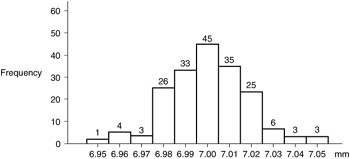Chapter 5: Normal Distribution
The normal distribution is one of the most important concepts used in statistics and the foundation of SPC. Knowledge of this distribution allows people to use many statistical tools and methods . These tools may be used to improve a production process. This chapter specifically will introduce the normal distribution and discuss some of its characteristics.
OVERVIEW
We are already familiar with histograms, which we define as the graphical representation of our data in a given time frame. (After all, histogram is the Greek word for history + graph ). Our interest, of course, is to identify the spread and the shape of our data. In the statistical world, if the histograms are symmetrical ”in the form of a smooth, bell-shaped curve ”we call them a "normal curve" or "normal distribution."
The pattern of our many manufacturing and nonmanufacturing operations produces outputs that follow the distinct pattern of a normal distribution (see Figure 5.1). For example, the machined riser height for a starter motor commutator follows the general pattern of the normal curve. Most of the parts are near the mean. Fewer measurements fall away from the mean.

Figure 5.1: A typical output of a normal distribution pattern.
An underlying law of nature emerges after observing many similar patterns of variation. Mathematicians have recognized this pattern and have developed formulas that describe the normal distribution. (For a more technical review, see Volume III, Part II of this series.)
EAN: 2147483647
Pages: 181
- Chapter III Two Models of Online Patronage: Why Do Consumers Shop on the Internet?
- Chapter VI Web Site Quality and Usability in E-Commerce
- Chapter VIII Personalization Systems and Their Deployment as Web Site Interface Design Decisions
- Chapter XIII Shopping Agent Web Sites: A Comparative Shopping Environment
- Chapter XVII Internet Markets and E-Loyalty